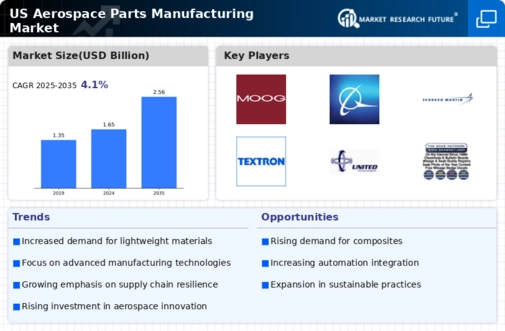Emerging Markets and Global Trade
Emerging markets are becoming increasingly influential in the aerospace parts-manufacturing market. Countries such as India and Brazil are investing heavily in their aerospace sectors, creating new opportunities for U.S. manufacturers. The expansion of global trade agreements facilitates the export of aerospace components, allowing U.S. manufacturers to tap into new markets. As these emerging economies develop their aviation infrastructure, the demand for high-quality aerospace parts is expected to rise. This trend indicates a potential for growth in the aerospace parts-manufacturing market as manufacturers seek to establish a foothold in these lucrative markets.
Growing Commercial Aviation Sector
The commercial aviation sector is expanding rapidly, which directly impacts the aerospace parts-manufacturing market. With an increase in air travel demand, airlines are expanding their fleets to accommodate more passengers. This growth is reflected in the projected increase in aircraft deliveries, which is expected to reach 40,000 units over the next two decades. Consequently, the need for high-quality aerospace components is rising, prompting manufacturers to scale up production. The aerospace parts-manufacturing market is thus positioned to thrive as it responds to the burgeoning requirements of the commercial aviation industry.
Government Investments in Aerospace
Government investments play a crucial role in shaping the aerospace parts-manufacturing market. The U.S. government has allocated substantial funding for aerospace research and development, aiming to bolster national security and technological leadership. In recent years, funding for aerospace initiatives has increased by over 15%, fostering innovation and collaboration between public and private sectors. This financial support encourages manufacturers to develop cutting-edge technologies and improve production capabilities. As a result, the aerospace parts-manufacturing market benefits from enhanced competitiveness and the ability to meet the evolving demands of the industry.
Rising Demand for Fuel-Efficient Aircraft
The aerospace parts-manufacturing market is significantly influenced by the increasing demand for fuel-efficient aircraft. Airlines are under pressure to reduce operational costs and minimize environmental impact, leading to a shift towards more efficient aircraft designs. According to industry reports, the market for fuel-efficient aircraft is projected to grow by 5% annually, prompting manufacturers to innovate and produce lightweight components. This trend necessitates the development of advanced materials and manufacturing techniques, which in turn stimulates growth in the aerospace parts-manufacturing market. As airlines invest in modern fleets, the demand for high-performance parts continues to rise.
Technological Advancements in Manufacturing
The aerospace parts-manufacturing market is experiencing a surge in technological advancements that enhance production efficiency and precision. Innovations such as additive manufacturing and advanced robotics are transforming traditional manufacturing processes. For instance, the integration of 3D printing technology allows for the creation of complex geometries that were previously unattainable, reducing material waste by up to 30%. Furthermore, automation in assembly lines is expected to increase productivity by approximately 20% over the next few years. These advancements not only streamline operations but also improve the quality of aerospace components, thereby driving growth in the aerospace parts-manufacturing market.






















Leave a Comment